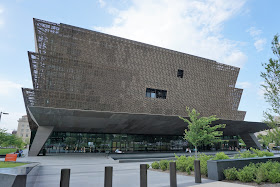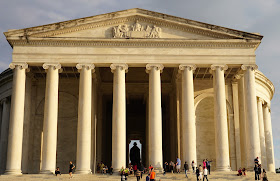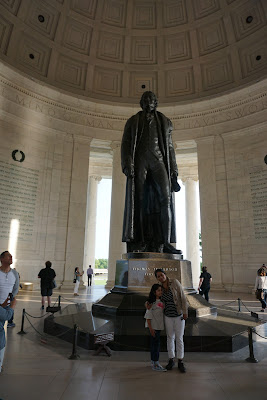After a few hours in the Smithsonian Art Museum, we made our way towards the Reflecting Pool and Tidal Basin. Bob had a long walk planned, and it was already mid-afternoon. I told him there was no way we could do all of this with what light we had left. He assured me that we could, and off we went.
There's always something interesting to see while walking through the D.C. streets, like Colossal Head 4 in front of the National Museum of Natural History. It is a copy of the original Olmec stone carving on display in a museum in Xalapa, Mexico:
Bob had tried to get tickets to the Smithsonian National Museum of African American History and Culture, which had just opened eight months before, but it was already sold out for the dates we were in D.C.
Walking past it really piqued our curiosity. This will be at the top of my list next time we are in D.C.:
The building looks like a giant slave ship:
. . . and the Lincoln Memorial can be seen to the west:
At the east end of the Reflecting Pool is the World War II Memorial, something I was surprised I didn't remember from my two previous visits:
The memorial flanks a plaza and fountain. One side commemorates the war in the Pacific, and the other the war in the Atlantic:
The two arches stand in front of a total of 56 pillars, each one representing a state or U.S. territory:
Memorable quotes are inscribed in nearby granite walls, like this one from Admiral Chester W Nimitz:
We walked between rows of cherry trees, part of the gift of 3,020 trees given to the U.S. by Tokyo, Japan, in 1912. Seeing these trees in full bloom is on my bucket list. We have seen their counterparts in Ueno Park in Tokyo in spring, and they were spectacular:
We could see our next stop, the Jefferson Memorial, at the far end of the Tidal Basin:
We gradually got closer . . .
. . . and closer . . .
. . . and closer . . .
. . . until we were there and could just make out Jefferson standing in the center of the neoclassical building, which was completed in 1943.
Jefferson himself, who stands 19 feet tall, came to live here in 1947:
The ceiling looks a lot like the ceiling in Rome's Pantheon:
Excerpts from the Declaration of Independence and other writings by Jefferson are carved onto the stone walls:
. . . which is topped by a triangular pediment depicting Jefferson (in the center) and the four additional members of the drafting committee of the Declaration of Independence as they submit their document to Congress:
As the sun drew closer to the horizon, it was time to move on.
The rear view of the monument:
It's well worth the walk from the Washington Memorial:
There's always something interesting to see while walking through the D.C. streets, like Colossal Head 4 in front of the National Museum of Natural History. It is a copy of the original Olmec stone carving on display in a museum in Xalapa, Mexico:
Walking past it really piqued our curiosity. This will be at the top of my list next time we are in D.C.:
The building looks like a giant slave ship:
We had seen the Washington Monument from a distance from several locations, but it was awe-inspiring to approach the actual structure. Too bad we couldn't climb the 897 stairs inside (which have been closed to tourists since 1971 anyway). The elevator is being renovated, and the building will be closed until at least 2019.
Over 554 feet tall, the Washington Monument is the tallest stone structure (and therefore also the tallest obelisk) in the world. It was started in 1848 and completed in 1884. It beat out the Cologne Cathedral to become the world's tallest structure, but then lost that title to the Eiffel Tower in 1889.
Fifty U.S. flags encircle the base of the monument, and hundreds of people were sitting or standing on the benches and grass surrounding it on the Sunday afternoon we were there:
It's impossible not to feel patriotic in the presence of this massive structure. It made me think of all the beautiful buildings and monuments that have been destroyed in wars and that are still being destroyed. What a blow that is to a culture.
The U.S. Capitol building can be seen to the east:
. . . and the Lincoln Memorial can be seen to the west:
We headed down the slope in the direction of the Reflecting Pool and the Lincoln Memorial:
At the east end of the Reflecting Pool is the World War II Memorial, something I was surprised I didn't remember from my two previous visits:
However, since the last time I was in Washington, D.C., was 1987, that's no surprise. This memorial was dedicated by President George W. Bush in 2004.
The lead-up to the monument is a series of bas reliefs depicting life during the war:
My favorite shows a family gathered around the radio listening to the news:
The memorial flanks a plaza and fountain. One side commemorates the war in the Pacific, and the other the war in the Atlantic:
The two arches stand in front of a total of 56 pillars, each one representing a state or U.S. territory:
I was moved by the floral tributes placed at the base of the pillars:
Especially this one placed by an Honor Flight group:
Memorable quotes are inscribed in nearby granite walls, like this one from Admiral Chester W Nimitz:
. . . and these words from President Roosevelt's December 1941 announcement of the bombing of Pearl Harbor:
President Roosevelt paid tribute to the women at home:
. . . as did Colonel Oveta Culp Hobby, the first director of the Women's Army Corps:
President Truman noted the importance of our allies:
I especially loved this quote from President Truman:
I think my favorite part of the World War II Memorial was the Freedom Wall, which is covered with 4,048 gold stars, each star representing 100 American service personnel who died or remained missing in the war. The stone below is inscribed "Here we mark the price of freedom":
Again, we looked west and saw the Lincoln Memorial on the other end of the Reflecting Pool:
Behind us to the east was the Washington Memorial:
We headed south towards the Tidal Basin, passing this monument to John Paul Jones, American Revolutionary War naval commander:
We gradually got closer . . .
. . . and closer . . .
. . . and closer . . .
. . . until we were there and could just make out Jefferson standing in the center of the neoclassical building, which was completed in 1943.
Jefferson himself, who stands 19 feet tall, came to live here in 1947:
Originally, a memorial to Theodore Roosevelt was going to be built here, but it never got off the ground. In 1934, President Franklin D. Roosevelt, a great fan of Jefferson, proposed a monument to Thomas Jefferson be built here instead. That idea took off, and five years later FDR laid the cornerstone:
Jefferson towers majestically above those who come to visit. From his pedestal he can even keep an eye on the Whitehouse (for all the good it's done):
Excerpts from the Declaration of Independence and other writings by Jefferson are carved onto the stone walls:
Massive Ionic columns hold up the portico:
Looking back at the Washington Monument, which seems to act as a magnetic force that draws one's gaze:
As the sun drew closer to the horizon, it was time to move on.
The rear view of the monument:
The elegant Jefferson Memorial is one of the most beautiful buildings in Washington, D.C.
It's well worth the walk from the Washington Memorial:
Coming Up: Part 2 of our walk around the Reflecting Pool and Tidal Basin

























































This really is an amazing walk. Can't wait for the rest of the story.
ReplyDeleteThat's got to be one of the best walks in the United States.
ReplyDelete